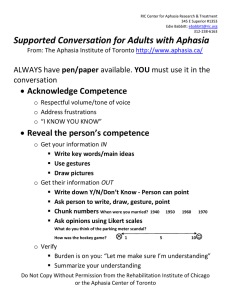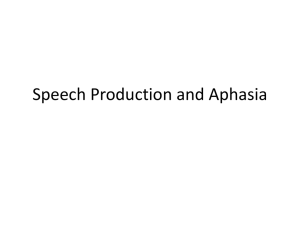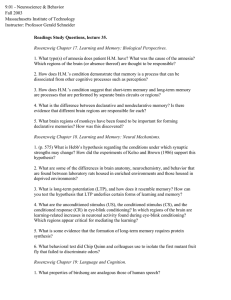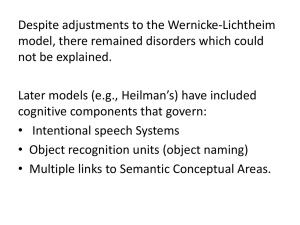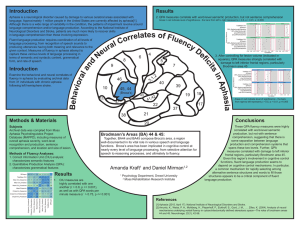Introduction People with aphasia generally experience better
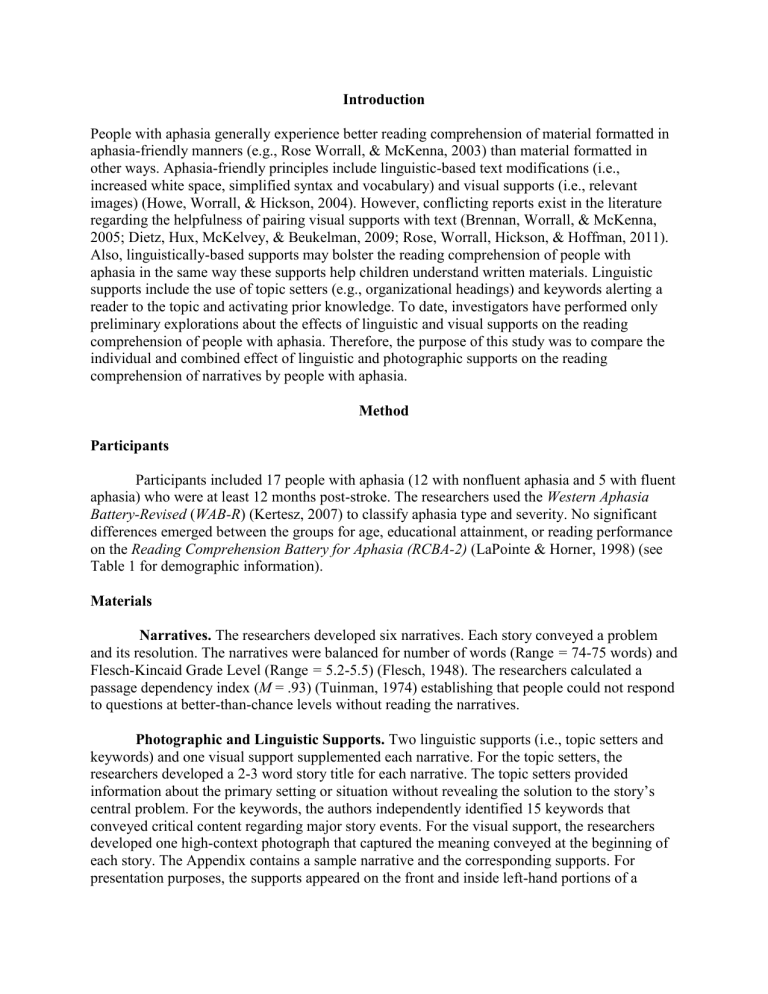
Introduction
People with aphasia generally experience better reading comprehension of material formatted in aphasia-friendly manners (e.g., Rose Worrall, & McKenna, 2003) than material formatted in other ways. Aphasia-friendly principles include linguistic-based text modifications (i.e., increased white space, simplified syntax and vocabulary) and visual supports (i.e., relevant images) (Howe, Worrall, & Hickson, 2004). However, conflicting reports exist in the literature regarding the helpfulness of pairing visual supports with text (Brennan, Worrall, & McKenna,
2005; Dietz, Hux, McKelvey, & Beukelman, 2009; Rose, Worrall, Hickson, & Hoffman, 2011).
Also, linguistically-based supports may bolster the reading comprehension of people with aphasia in the same way these supports help children understand written materials. Linguistic supports include the use of topic setters (e.g., organizational headings) and keywords alerting a reader to the topic and activating prior knowledge. To date, investigators have performed only preliminary explorations about the effects of linguistic and visual supports on the reading comprehension of people with aphasia. Therefore, the purpose of this study was to compare the individual and combined effect of linguistic and photographic supports on the reading comprehension of narratives by people with aphasia.
Method
Participants
Participants included 17 people with aphasia (12 with nonfluent aphasia and 5 with fluent aphasia) who were at least 12 months post-stroke. The researchers used the Western Aphasia
Battery-Revised ( WAB-R ) (Kertesz, 2007) to classify aphasia type and severity. No significant differences emerged between the groups for age, educational attainment, or reading performance on the Reading Comprehension Battery for Aphasia (RCBA-2) (LaPointe & Horner, 1998) (see
Table 1 for demographic information).
Materials
Narratives.
The researchers developed six narratives. Each story conveyed a problem and its resolution. The narratives were balanced for number of words (Range = 74-75 words) and
Flesch-Kincaid Grade Level (Range = 5.2-5.5) (Flesch, 1948). The researchers calculated a passage dependency index ( M = .93) (Tuinman, 1974) establishing that people could not respond to questions at better-than-chance levels without reading the narratives.
Photographic and Linguistic Supports. Two linguistic supports (i.e., topic setters and keywords) and one visual support supplemented each narrative. For the topic setters, the researchers developed a 2-3 word story title for each narrative. The topic setters provided information about the primary setting or situation without revealing the solution to the story’s central problem. For the keywords, the authors independently identified 15 keywords that conveyed critical content regarding major story events. For the visual support, the researchers developed one high-context photograph that captured the meaning conveyed at the beginning of each story. The Appendix contains a sample narrative and the corresponding supports. For presentation purposes, the supports appeared on the front and inside left-hand portions of a
manila folder; the narratives appeared on the inside right-hand portion of the folders. All text was double-spaced and appeared in 18-point bold-faced font.
Comprehension assessments.
The researchers developed 15 multiple-choice questions to assess participants’ comprehension of each narrative. Answer choices included the correct response plus three foils presented in a Written Choice format (Garrett & Beukelman, 1992).
Procedures
The experimental tasks included reading the six narratives—each in a condition using none, one, or two of the reading supports—and completing the associated comprehension assessment. The participants viewed the reading supports on the front of the folder for 30 seconds prior to the researcher opening the folder to display both the supports and the narrative.
Stimuli were left in view of participants while they responded to questions. The researchers systematically alternated the pairing of stories across the various conditions.
Data Analysis
The researchers employed a mixed ANOVA ( p ≤ .05) to determine whether significant differences existed between the participants with fluent versus nonfluent aphasia across the six reading support conditions. As appropriate, computation of Fisher’s Protected LSD procedure
(Rosner, 2005) ( p ≤ .05; critical LSD value = 7.212) provided a means of further evaluating differences among the support conditions.
Results
Computation of a mixed ANOVA revealed no main effects for aphasia type ( F
(1, 15)
=
.342, p = .568, MSE = 2881.664) or reading support condition ( F
(5, 75)
= 1.427, p = .224, MSE =
108.890). However, a significant interaction effect occurred between aphasia type and reading supports ( F
(5, 75)
= 2.702, p = .027, MSE = 189.890) (see Figure 1). The post-hoc analyses revealed that the participants with fluent aphasia attained significantly higher reading comprehension accuracy scores in the No Support (LSD = 11.36), Keywords (LSD = 15.60), and
Photograph (LSD = 15.94) conditions than the participants with nonfluent aphasia; the two groups performed comparably in the other reading support conditions. Table 2 provides individual performance data.
Fluent Aphasia
For the participants with fluent aphasia, reading with the support of a photograph produced significantly higher comprehension scores than any of the other conditions
(Photograph vs. No Support: LSD = 8.75; Photograph vs. Topic Setter: LSD = 15.00;
Photograph vs. Keywords: LSD = 8.25; Photograph vs. Photograph + Topic Setter: LSD = 13.75;
Photograph vs. Photograph + Keywords: LSD = 20.00). The participants with fluent aphasia also demonstrated significantly higher reading comprehension scores in the No Support condition than the Photograph + Keywords condition (LSD = 11.25) and in the Keywords condition than the Photograph + Keywords condition (LSD = 11.75). Overall, this group exhibited higher levels
of reading comprehension accuracy given photographic supports than given linguistic supports or a combination of linguistic and photographic supports. The combination of Photographs +
Keywords was especially harmful to the reading comprehension of participants with fluent aphasia.
Nonfluent Aphasia
The participants with nonfluent aphasia achieved significantly higher reading comprehension scores when passages appeared with a combination of photographic and linguistic supports than when they appeared with only one type of support. Their reading comprehension in the Photograph condition was equivalent to that achieved in the Topic Setters condition (LSD = 3.12) and in the No Support condition (LSD = 4.17); they achieved significantly higher reading comprehension scores in the Photograph + Topic Setter (LSD =
8.95) and the Photograph + Keywords (LSD= 11.04) conditions than in the Keyword condition.
Hence, the participants with nonfluent aphasia differed from their fluent counterparts in that the former benefitted from having multiple rather than single supports.
Discussion
The results of this study suggest that visual supports positively affect the reading comprehension of people with aphasia. In particular, it appears that photographs bolster the reading comprehension of people with aphasia when paired with narrative text. These findings also highlight that differences exist regarding how people with fluent and nonfluent aphasia respond to the presence of reading supports. More specifically, people with fluent aphasia appear to benefit the most from photographic supports provided in isolation, whereas people with nonfluent aphasia benefit most from a combination of photographic and linguistic supports.
These varied performance patterns may be due to unique cognitive processing deficits and preserved skills not reflected in WAB-R (Kertesz, 2007) or RCBA-2 (LaPointe & Horner) scores.
However, the small sample size—especially for the participants with fluent aphasia ( N = 5)—is a study limitation that may have confounded the results. Overall, reading supports appear to facilitate comprehension in some instances and with some individuals with aphasia; however, decisions about which types of supports to present and in what combination(s) to present them require careful consideration of residual language and cognitive skills.
References
Brennan, A., Worrall, L., & McKenna, K. (2005). The relationship between specific features of aphasia-friendly written material and comprehension of written material for people with aphasia: An exploratory study. Aphasiology , 19 , 693-711.
Dietz, A., Hux, K., Beukelman, D. R., McKelvey, M. L., & Weissling, K. (2009). Reading comprehension by people with chronic aphasia: A comparison of three levels of visuographic contextual support. Aphasiology, 23, 1053-1064.
Howe, T.J., Worrall, L.E., Hickson, M.H. (2004). What is an aphasia-friendly environment?
Aphasiology, 18 (11), 1015-1037.
McNeil, M. (1983). Aphasia: Neurological considerations. Topics in Language Disorders, 3, 1-
19.
McNeil, M., Odell, K., & Tseng, C. H. (1991). Toward the integration of resource allocation into a general theory of aphasia. Clinical Aphasiology, 20 , 21-39.
Murray, L. (1999). Attention and aphasia: Theory, research and clinical implications.
Aphasiology, 13 , 91-111Rose, T. A., Worrall, L. E., Hickson, L. M., & Hoffmann, T. C.
(2011). Aphasia friendly written health information: Content and design characteristics.
International Journal of Speech-Language Pathology, 13, 335-347.
Rose, T. A., Worrall, L. E., & McKenna, K. T. (2003). The effectiveness of aphasia-friendly principles for printed health education materials for people with aphasia following stroke.
Aphasiology, 17 , 947-963.
Table 1
Participant Demographic and Assessment Data
Participant number
Age
(years) Gender
1
2
3
4
5
6
7
8
9
10
11
12
13
14
-a
73
42
66
70
64
54
64
59
59
64
50
57
82
F
F
F
F
F
M
F
M
M
M
M
M
F
F
15
16
85
56
M
F
17 79 M a
Participant refused to provide age.
Time poststroke
(months)
66
15
14
156
29
78
48
86
35
268
47
156
73
264
58
27
71
Education
(years)
16
16
12
12
12
18
18
12
13
12
16
18
18
12
14
16
16
WAB-R aphasia type
Broca’s
Broca’s
Broca’s
Broca’s
Global
Broca’s
Global
Broca’s
Transcortical motor
Broca’s
Global
Broca’s
Conduction
Anomic
Transcortical sensory
Anomic
Wernicke’s
WAB-R aphasia quotient
61.8
25.1
16.6
78.1
88.7
62.7
60.9
73.6
72.0
61.1
63.3
52.1
20.9
59.4
34.4
33.4
72.4
RCBA-2 total score
68
64
66
91
86
45
51
90
86
84
84
88
43
58
49
55
92
Table 2
Individual Participant’s Reading Comprehension Percent Correct Scores in Each Condition
Aphasia type
Nonfluent
No support
Topic setter Keywords Photograph
Photograph +
Topic setter
Photograph
+ Keywords
1
2
75.00
87.50
68.75
100.00
80.00
75.00
75.00
75.00
93.75
75.00
81.25
93.75
3
4
93.75
81.25
87.50
75.00
93.75
93.75
87.50
93.75
100.00
62.50
81.25
100.00
5
6
7
50.00
37.50
43.75
37.50
25.00
31.25
43.75
37.50
37.50
31.25
68.75
50.00
8
9
56.25
43.75
68.75
37.50
43.75
25.00
68.75
43.75
87.50
62.50
62.50
31.25
10
68.75
37.50
68.75
37.50
75.00
31.25
100.00
43.75
81.25
62.50
68.75
43.75
11
12
50.00
37.50
56.25
50.00
56.25
43.705
62.50
37.50
43.75
43.75
62.50
62.50
Fluent
13
14
15
16
17
Grand Mean
Standard
Dev
93.75
87.50
31.25
62.50
81.25
63.24
21.86
87.50
93.75
6.25
68.75
68.75
62.13
24.45
81.25
81.25
40.00
68.75
87.50
60.73
24.88
100.00
93.75
31.25
81.25
93.75
68.75
24.61
62.50
93.75
25.00
75.00
75.00
65.44
22.87
81.25
87.50
6.25
62.50
62.50
65.07
23.29
80 80.00
No Support
75
Topic Setter
71.75
71.25
Keywords
70
65
67.19
65.10
64.06
66.25
65.00
Photographs x
60
60.94
59.89
60.00 x Photographs +
Topic Setters x x x
Photographs +
Keywords
56.15
55
Nonfluent Fluent
Type of aphasia
Figure 1. The average percentage comprehension questions correct across six types of pre-reading support between people with nonfluent and fluent aphasia.
Appendix
Narrative
Example Narrative Topic Setter, Key words and Photographic Supports
Betty walked to the kitchen early one morning to make her first cup of coffee. Heading to the living room, she noticed a young man sprawled on the couch. Disoriented, the man stood, took a few shaky steps, and then fell back onto the couch. Betty debated whether she should confront the man or telephone the police. She decided to call for assistance. An officer arrived and approached the stranger. The man said he was visiting a friend nearby and had attended a party the previous night. Leaving at 3:00am, he lost his way and thought Betty’s house was his friend’s. In an attempt to not wake anyone, he climbed in an open window and curled up on the couch to sleep. The officer escorted him out to the police car and charged him with trespassing.
Topic Setter
Home Break-In
Keywords
Betty couch morning police lost coffee
Call window living room
Officer
Charged man party trespassing 3:00am
Photograph
Note: Due to space limitations, materials are not formatted as described in the materials section.
